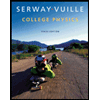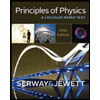Problem 1Q: We fully submerge an irregular 3 kg lump of material in a certain fluid. The fluid that would have... Problem 2Q: Figure 14-21 shows four situations in which a red liquid and a gray liquid are in a U-tube. In one... Problem 3Q: A boat with an anchor on board floats in a swimming pool that is somewhat wider than the boat. Does... Problem 4Q: Figure 14-22 shows a tank filled with water. Five horizontal floors and ceilings are indicated; all... Problem 5Q: The teapot effect. Water poured slowly from a teapot spout can double back under the spout for a... Problem 6Q: Figure 14-24 shows three identical open-top containers filled to the brim with water; toy ducks... Problem 7Q: Figure 14-25 shows four arrangements of pipes through which water flows smoothly toward the right.... Problem 8Q: A rectangular block is pushed face-down into three liquids, in turn. The apparent weight Wapp of the... Problem 9Q: Water flows smoothly in a horizontal pipe. Figure 14-27 shows the kinetic energy K of a water... Problem 10Q: We have three containers with different Liquids. The gauge pressure pg versus depth h is plotted in... Problem 1P: ILW A fish maintains its depth in fresh water by adjusting the air content of porous bone or air... Problem 2P: A partially evacuated airtight container has a tight-fitting lid of surface area 77 m2 and... Problem 3P: SSM Find the pressure increase in the fluid in a syringe when a nurse applies a force of 42 N to the... Problem 4P: Three liquids that will not mix are poured into a cylindrical container. The volumes and densities... Problem 5P: SSM An office window has dimensions 3.4 m by 2.1 m. As a result of the passage of a storm, the... Problem 6P Problem 7P: In 1654 Otto von Guericke, inventor of the air pump, gave a demonstration before the noblemen of the... Problem 8P: The bends during flight. Anyone who scuba dives is advised not to fly within the next 24 h because... Problem 9P: Blood pressure in Argentinosaurus. a If this long-necked, gigantic sauropod had a head height of 21... Problem 10P: The plastic tube in Fig. 14-30 has a cross-sectional area of 5.00 cm2. The tube is filled with water... Problem 11P: Giraffe bending to drink. In a giraffe with its head 2.0 m above its heart and its heart 2.0 m above... Problem 12P: The maximum depth dmax that a diver can snorkel is set by the density of the water and the fact that... Problem 13P: At a depth of 10.5 km, the Challenger Deep in the Marianas Trench of the Pacific Ocean is the... Problem 14P: Calculate the hydrostatic difference in blood pressure between the brain and the foot in a person of... Problem 15P: What gauge pressure must a machine produce in order to suck mud of density 1800kg/m3 up a tube by a... Problem 16P: Snorkeling by humans and elephants. When a person snorkels, the lungs are connected directly to the... Problem 17P: SSM Crew members attempt to escape from a damaged submarine 100 m below the surface. What force must... Problem 18P: In Fig. 14-32, an open tube of length L = 1.8 m and cross-sectional area A = 4.6 cm2 is fixed to the... Problem 19P: GO A large aquarium of height 5.00 m is filled with fresh water to a depth of 2.00 m. One wall of... Problem 20P: The L-shaped fish tank shown in Fig. 14-33 is filled with water and is open at the top. If d = 5.0... Problem 21P: SSM Two identical cylindrical vessels with their bases at the same level each contain a liquid of... Problem 22P Problem 23P: GO In analyzing certain geological features, it is often appropriate to assume that the pressure at... Problem 24P: GO In Fig. 14-35, water stands at depth D = 35.0 m behind the vertical upstream face of a dam of... Problem 25P: In one observation, the column in a mercury barometer as is shown in Fig. 14-5a has a measured... Problem 26P: To suck lemonade of density 1000 kg/m3 up a straw to a maximum height of 4.0 cm, what minimum gauge... Problem 27P: SSM What would be the height of the atmosphere if the air density a were uniform and b decreased... Problem 28P: A piston of cross-sectional area a is used in a hydraulic press to exert a small force of magnitude... Problem 29P: In Fig 14-37, a spring of spring constant 3.00 104 N/m is between a rigid beam and the output... Problem 30P: A 5.00 kg object is released from rest while fully submerged in a liquid. The liquid displaced by... Problem 31P: SSM A block of wood floats in fresh water with two-thirds of its volume V submerged and in oil with... Problem 32P: In Fig. 14-38, a cube of edge length L = 0.600 m and mass 450 kg is suspended by a tope in an open... Problem 33P: SSM An iron anchor of density 7870kg/m3 appears 200 N lighter in water than in air. a What is the... Problem 34P: A boat floating in fresh water displaces water weighing 35.6 kN. a What is the weight of the water... Problem 35P: Three children, each of weight 356 N, make a log raft by lashing together logs of diameter 0.30 m... Problem 36P: GO In Fig. 14-39a, a rectangular block is gradually pushed face-down into a liquid. The block has... Problem 37P: ILW A hollow spherical iron shell floats almost completely submerged in water. The outer diameter is... Problem 38P: GO A small solid ball is released from rest while fully submerged in a liquid and then its kinetic... Problem 39P: SSM WWW A hollow sphere of inner radius 8.0 cm and outer radius 9.0 cm floats half-submerged in a... Problem 40P: Lurking alligators. An alligator waits for prey by floating with only the top of its head exposed,... Problem 41P: What fraction of the volume of an iceberg density 917 kg/m3 would be visible if the ice berg floats... Problem 42P: A Flotation device is in the shape of a right cylinder, with a height of 0.500 m and a face area of... Problem 43P: When researchers find a reasonably complete fossil of a dinosaur, they can determine the mass and... Problem 44P: A wood block mass 3.67 kg, density 600 kg/m3 is fitted with lead density 1.14 104 kg/m3 so that it... Problem 45P: GO An iron casting containing a number of cavities weighs 6000 N in air and 4000 N in water. What is... Problem 46P: GO Suppose that you release a small ball from rest at a depth of 0.600 m below the surface in a pool... Problem 47P: The volume of air space in the passenger compartment of an 1800kg car is 5.00 m3. The volume of the... Problem 48P: GO Figure 14-44 shows an iron ball suspended by thread of negligible mass from an upright cylinder... Problem 49P: Canal effect. Figure 14-45 shows an anchored barge that extends across a canal by distance d = 30 m... Problem 50P: Figure 14-46 shows two sections of an old pipe system that runs through a hill, with distances dA =... Problem 51P: SSM A garden hose with an internal diameter of 1.9 cm is connected to a stationary lawn sprinkler... Problem 52P: Two streams merge to form a river. One stream has a width of 8.2 m, depth of 3.4 m, and current... Problem 53P: SSM Water is pumped steadily out of a flooded basement at 5.0 m/s through a hose of radius 1.0 cm,... Problem 54P: GO The water flowing through a 1.9 cm inside diameter pipe flows out through three 1.3 cm pipes. a... Problem 55P: How much work is done by pressure in forcing 1.4 m3 of water through a pipe having an internal... Problem 56P: Suppose that two tanks, 1 and 2, each with a large opening at the top, contain different liquids. A... Problem 57P: SSM A cylindrical tank with a large diameter is filled with water to a depth D = 0.30 m. A hole of... Problem 58P: The intake in Fig. 14-47 has cross-sectional area of 0.74 m2 and water flow at 0.40 m/s. At the... Problem 59P: SSM Water is moving with a speed of 5.0 m/s through a pipe with a cross-sectional area of 4.0 cm2.... Problem 60P: Models of torpedoes are sometimes tested in a horizontal pipe of flowing water, much as a wind... Problem 61P: ILW A water pipe having a 2.5 cm inside diameter carries water into the basement of a house at a... Problem 62P: A pitot tube Fig. 14-48 is used to determine the airspeed of an airplane. It consists of an outer... Problem 63P Problem 64P: GO In Fig. 14-49, water flows through a horizontal pipe and then out into the atmosphere at a speed... Problem 65P: SSM WWW A venturi meter is used to measure the flow speed of a fluid in a pipe. The meter is... Problem 66P: Consider the venturi tube of Problem 65 and Fig. 14-50 without the manometer. Let A equal 5a.... Problem 67P: ILW In Fig. 14-51, the fresh water behind a reservoir dam has depth D = 15 m. A horizontal pipe 4.0... Problem 68P: GO Fresh water flows horizontally from pipe section 1 of cross-sectional area A1 into pipe section 2... Problem 69P: A liquid of density 900 kg/m3 flows through a horizontal pipe that has a cross-sectional area of... Problem 70P: GO In Fig. 14-53, water flows steadily from the left pipe section radius r1 = 2.00R, through the... Problem 71P: Figure 14-54 shows a stream of water flowing through a hole at depth h = 10 cm in a tank holding... Problem 72P: GO A very simplified schematic of the rain drainage system for a home is shown in Fig. 14-55. Rain... Problem 73P: About one-third of the body of a person floating in the Dead Sea will be above the waterline.... Problem 74P: A simple open U-tube contains mercury. When 11.2 cm of water is poured into the right arm of the... Problem 75P: If a bubble in sparkling water accelerates upward at the rate of 0.225 m/s2 and has a radius of... Problem 76P: Suppose that your body has a uniform density of 0.95 times that of water. a If you float in a... Problem 77P Problem 78P: Caught in an avalanche, a skier is fully submerged in flowing snow of density 96 kg/m3. Assume that... Problem 79P: An object hangs from a spring balance. The balance registers 30 N in air, 20 N when this object is... Problem 80P: In an experiment, a rectangular block with height h is allowed to float in four separate liquids. In... Problem 81P: SSM Figure 14-30 shows a modified U-tube: the right arm is shorter than the left arm. The open end... Problem 82P: What is the acceleration of a rising hot-air balloon if the ratio of the air density outside the... Problem 83P: Figure 14-56 shows a siphon, which is a device for removing liquid from a container. Tube ABC must... Problem 84P: When you cough, you expel air at high speed through the trachea and upper bronchi so that the air... Problem 85P: A tin can has a total volume of 1200 cm3 and a mass of 130 g. How many grams of lead shot of density... Problem 86P: The tension in a string holding a solid block below the surface of a liquid of density greater than... Problem 87P: What is the minimum area in square meters of the top surface of an ice slab 0.441 m thick floating... Problem 88P: A 8.60 kg sphere of radius 6.22 cm is at a depth of 2.22 km in seawater that has an average density... Problem 89P: a For seawater of density 1.03 g/cm3, find the weight of water on top of a submarine at a depth of... Problem 90P: The sewage outlet of a house constructed on a slope is 6.59 m below street level. If the sewer is... format_list_bulleted



 Physics for Scientists and Engineers, Technology ...PhysicsISBN:9781305116399Author:Raymond A. Serway, John W. JewettPublisher:Cengage Learning
Physics for Scientists and Engineers, Technology ...PhysicsISBN:9781305116399Author:Raymond A. Serway, John W. JewettPublisher:Cengage Learning College PhysicsPhysicsISBN:9781285737027Author:Raymond A. Serway, Chris VuillePublisher:Cengage Learning
College PhysicsPhysicsISBN:9781285737027Author:Raymond A. Serway, Chris VuillePublisher:Cengage Learning Principles of Physics: A Calculus-Based TextPhysicsISBN:9781133104261Author:Raymond A. Serway, John W. JewettPublisher:Cengage Learning
Principles of Physics: A Calculus-Based TextPhysicsISBN:9781133104261Author:Raymond A. Serway, John W. JewettPublisher:Cengage Learning College PhysicsPhysicsISBN:9781305952300Author:Raymond A. Serway, Chris VuillePublisher:Cengage Learning
College PhysicsPhysicsISBN:9781305952300Author:Raymond A. Serway, Chris VuillePublisher:Cengage Learning Physics for Scientists and Engineers: Foundations...PhysicsISBN:9781133939146Author:Katz, Debora M.Publisher:Cengage Learning
Physics for Scientists and Engineers: Foundations...PhysicsISBN:9781133939146Author:Katz, Debora M.Publisher:Cengage Learning




